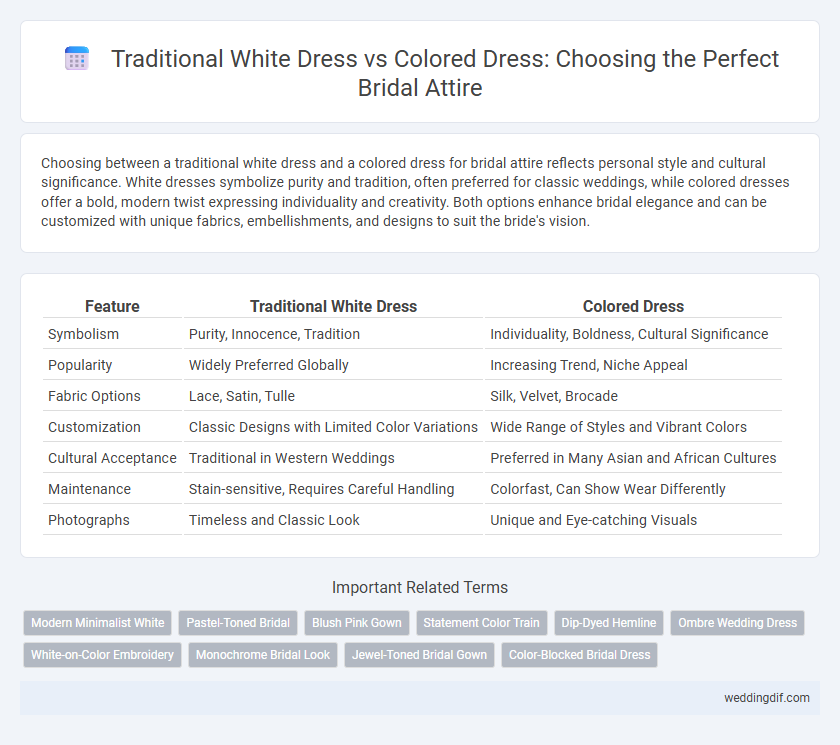Choosing between a traditional white dress and a colored dress for bridal attire reflects personal style and cultural significance. White dresses symbolize purity and tradition, often preferred for classic weddings, while colored dresses offer a bold, modern twist expressing individuality and creativity. Both options enhance bridal elegance and can be customized with unique fabrics, embellishments, and designs to suit the bride's vision.
Table of Comparison
| Feature | Traditional White Dress | Colored Dress |
|---|---|---|
| Symbolism | Purity, Innocence, Tradition | Individuality, Boldness, Cultural Significance |
| Popularity | Widely Preferred Globally | Increasing Trend, Niche Appeal |
| Fabric Options | Lace, Satin, Tulle | Silk, Velvet, Brocade |
| Customization | Classic Designs with Limited Color Variations | Wide Range of Styles and Vibrant Colors |
| Cultural Acceptance | Traditional in Western Weddings | Preferred in Many Asian and African Cultures |
| Maintenance | Stain-sensitive, Requires Careful Handling | Colorfast, Can Show Wear Differently |
| Photographs | Timeless and Classic Look | Unique and Eye-catching Visuals |
Introduction: The Evolution of Bridal Attire
Traditional white bridal dresses symbolize purity and have dominated Western weddings since the 19th century, popularized by Queen Victoria's 1840 wedding gown. Colored bridal dresses, rooted in diverse cultural customs and modern fashion trends, offer personalized expression and cultural significance beyond Western norms. The evolution of bridal attire reflects increasing acceptance of individuality, where brides choose white or colored gowns based on heritage, personal style, and contemporary influences.
Symbolism Behind the Traditional White Dress
The traditional white bridal dress symbolizes purity, innocence, and new beginnings, a custom popularized by Queen Victoria in the 19th century and now deeply embedded in Western wedding culture. White dresses also represent a blank canvas, reflecting hope and honesty in the union. In contrast, colored dresses often carry cultural or personal symbolism, but white remains a timeless emblem of the bride's fresh start and commitment.
The Rise of Colored Wedding Dresses
Colored wedding dresses have gained significant popularity as brides seek unique and personalized alternatives to traditional white gowns. Vibrant hues like blush pink, deep red, and pastel blue symbolize cultural heritage and individual expression, reflecting a shift in bridal fashion trends. Designers are increasingly incorporating bold colors and intricate patterns, redefining the bridal attire market with innovative and diverse options.
Cultural Influences on Bridal Color Choices
Cultural influences significantly shape bridal color choices, where traditional white dresses symbolize purity and are prevalent in Western weddings, while vibrant colored dresses hold deep meaning in many Eastern and African cultures, reflecting joy, prosperity, and heritage. In Indian weddings, red is often chosen for its association with fertility and auspiciousness, whereas in Chinese ceremonies, red symbolizes good luck and happiness. Understanding these cultural nuances helps brides select attire that honors their heritage while expressing personal style.
Pros and Cons of Wearing a White Wedding Dress
Wearing a traditional white wedding dress symbolizes purity and timeless elegance, making it a classic choice embraced by many brides worldwide. However, white dresses can highlight fabric imperfections and stains more easily, requiring careful handling throughout the day. Opting for a white gown might limit personal expression compared to colored dresses, which offer unique cultural significance and individuality.
Pros and Cons of Choosing a Colored Bridal Dress
Choosing a colored bridal dress allows for unique personal expression and cultural significance, often making the bride stand out with vibrant, eye-catching hues. However, colored dresses can be less versatile for future wear and may not align with traditional wedding themes, possibly leading to limited resale value. While offering individuality, selecting a non-white gown requires careful consideration of color symbolism and wedding color scheme compatibility.
Celebrity Influence: White vs Colored Bridal Trends
Celebrity influence significantly shapes bridal attire trends, with traditional white dresses symbolizing classic elegance and purity, popularized by icons like Grace Kelly and Kate Middleton. In contrast, celebrities such as Priyanka Chopra and Lady Gaga have propelled the rise of colored bridal dresses, showcasing boldness and individuality that challenge convention. This shift highlights a growing acceptance of personalized bridal fashion, blending cultural diversity and contemporary style.
Seasonal Factors: Color Choices for Different Wedding Dates
Seasonal factors play a significant role in choosing bridal attire, with the traditional white dress often favored for spring and summer weddings due to its light, airy appearance that complements warm weather. Colored bridal dresses in hues such as deep reds, emerald greens, and rich purples are popular choices for fall and winter ceremonies, reflecting the natural palette of those seasons and adding warmth to the ensemble. Brides often select colors that harmonize with their wedding date, venue, and surrounding seasonal foliage to enhance the overall aesthetic and mood of their special day.
Tips for Choosing Between White and Colored Bridal Dresses
Choosing between a traditional white dress and a colored bridal gown depends on personal style, wedding theme, and cultural significance. Brides should consider skin tone compatibility, venue setting, and desired level of uniqueness when selecting colors such as blush, champagne, or bold jewel tones. Consulting with a bridal consultant and trying multiple options ensures the perfect balance between tradition and modern expression for a memorable wedding day.
Final Thoughts: Personalizing Your Bridal Attire
Choosing between a traditional white dress and a colored bridal gown allows brides to express their unique style while honoring cultural or personal preferences. White dresses symbolize purity and timeless elegance, whereas colored dresses offer a bold statement and can reflect individual personality or heritage. Personalizing bridal attire by selecting fabric, embellishments, and silhouette enhances the meaningfulness of the ensemble, ensuring it resonates with the bride's vision for her special day.
Traditional White Dress vs Colored Dress for bridal attire. Infographic

 weddingdif.com
weddingdif.com